#not to mention the quality got so absurdly bad in the recent years it's painful
Photo
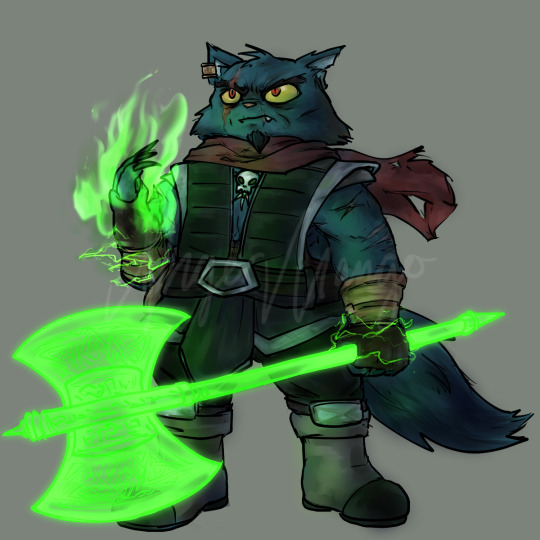
Magax (Neopets) redesign
Got inspired again after the Gilly redesign from before for another fun take on an existing character. Here’s the original edgy old cat who was woefully neglected by TNT in terms of character potential given he had a whole ~mysterious dark past~ and a documented rivalry with a fairly popular villain.
I was doing something more on the consolidation of designs path as Magax has had a load of designs over the years (and/or TNT was inconsistent in their art and designs sometimes...) so I tried to keep the elements of his core look while adding little embellishments or flairs. I like to think of Magax as a weary old soul who lives in a graveyard hunting ghosts and monsters every night so he looks kind of mangy and mean from years spent out alone in the deep Haunted Woods - but I’m sure it’s just his face, he’s probably an okay guy.
So yeah I kept most of Magax’s iconic features like his earring, eye scar, and goatee seeing as those seem to be staples in his look
Since I made him scarred all over I tried to make Magax’s famous eye scar stand out more so it’s a bigger, more raw-looking mark rather than just a thin line. I like to think that he got it when he fought Hubrid Nox for the first time after he turned his back on the way of evil, and during the battle Nox nailed him in the face with something that later became a trademark of his look.
Added on more scars and a chewed up ear to up the Edge on the look and show off that he’s a fighter, the old grizzled lone warrior type
The scarf is a nod to one of his prehistoric designs where he had a red cape and totally different armour - maybe it’s the same cape, worn with age and repurposed to keep his neck from getting chilly without his mane now
Clawsss
Does Magax wear manacles? Gloves? Neither? The NeoTeam artists can’t seem to decide, so why not all at once in a fingerless-glove-with-braces combo?
Magax has always worn this kind of vest thingy in some form and it’s changed colours from grey to black to green so i settled for a dull near-black green since green seems to be a part of his thing. He also kind of just wears it as one layer without anything else underneath, which I mean fair enough when you’re a magical warrior you probably don’t worry about that stuff. I put a kind of singlet underneath you can barely see just so he can say he’s got some layers
The belt combines his old design buckle and new design where he has a random bag on it but i figure a guy’s allowed to have somewhere to hide his... whatever is meant to be in there
His green magic is just rendered like that because I was having fun with layer blending modes and filters. The Flash-era effects don’t really give his magic powers much in way of visual flair nor are they that consistent: They look more or less like solid green bars and orbs in his games, while in other official art it’s rendered either like flames or lightning (plus his Neopets TGC card had him down as a Fire element alignment). I did a bit of both because Rule of Cool but I imagine that his magic is unique in that it manifests pretty much however he wants as a kind of pure raw energy magic.
His trusty Darklight Axe I gave it a little bit of a makeover too with a heavy battleaxe design and engravings on the head just because it looks sick. I assume it’s made out of the same green magic he wields so it’s kind of like a solid power construct or something (like Green Lantern? idk) I find it weird that his axe is only shown in art and alluded to in his Neopedia article as if it’s a normal if not staple part of his arsenal - heck, even his name suggests it’s like his signature weapon of choice, yet he doesn’t actually use it in his games to fight and instead just uses shooty beam spam
Bonus: OG Magaxes for comparing -


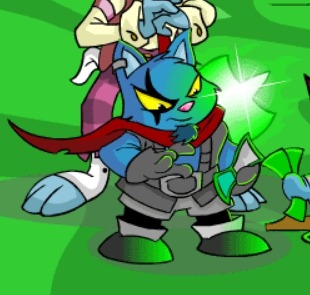
#neopets#neotag#neoart#magax#redesign#>>mango(t)art#oh magax edgy cat man who has been ignored soundly by TNT as a potential plot-interesting/relevant character#TNT straight up made a bunch of OCs some of whom had hinted complex and deep back stories or history and then just forgot or ignored them#maybe Magax's weird unrevealed dark past and heinous crimes worthy of exile transcend the fourth wall#so he is doomed to rot in stagnant creative limbo where even his creators refuse to interact with him#seriously though in the era of neopets straight up making random characters for game and world building fodder i used to find magax cool#and i did wish and hope for more explanation on his whole reformed villain past and rivalry with Hubrid Nox#I mean it was weirder that Hubrid was a character who had a number of game appearances or was alluded to#yet Magax only was shown being opposed to him in his own game and even then couldn't even fight Nox there just get inconvenienced#then they straight up murdered Nox in one of the plots and only showed Magax in an Advent Calendar animation#where he was reacting to Nox being dead#and later got a few weird ones where he's apparently gone and befriended ghost!hubrid and frequently goofs around with him#and even then i find the canonicity of the Advent Calendar animations dubious#since they range from festive fluff with no real relevance to borderline crack#not to mention the quality got so absurdly bad in the recent years it's painful#anyways that's enough crack in the tags
57 notes
·
View notes
Text
Kobayashi’s Maid Dragon Episode 4 Notes

These yellow hats are tsuugakubou 通学帽, “commuting to school hats.” They are required by many elementary schools in Japan; students must wear them when traveling to and from school (which most children do by walking, at least part of the way; school buses aren't a thing) for various reasons. The most commonly cited is “to avoid traffic accidents” by making the children stand out, but others include preventing heatstroke, making them easier to spot for teachers, or differentiating which grade a student is in.
As the previous sentence implies, their design may change as you go up the grades (yellow for first graders, blue for older, as an example) or sometimes by gender. Depends on what the school wants to do with them.
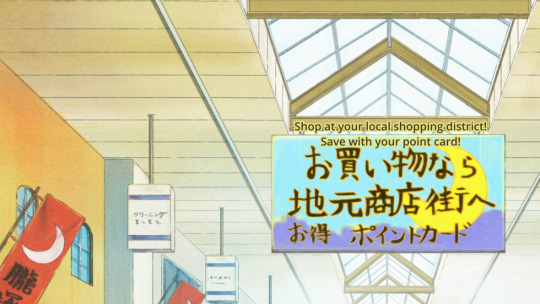
Point cards are an absurdly popular way of encouraging repeat business in Japan, with lots of small business using non-electronic ones (marked by just a custom stamp). If you’re not careful your wallet will be overflowing with them in no time.

The “zuuun” sound she makes here is, as you could probably guess, the sound effect for this sort of emotional gloom or a sense of heaviness (physical or not).
Japanese has a huge wealth of these “sound effect” words, and they’re a pretty normal part of conversation—especially for kids, but also adults and to an extent even in formal situations. You’re surely familiar with “onomatopoeia” (also known as a phonomime), a word that sound like a sound; “buzz” being a common example. You may be less familiar with the words phenomime and psychomime; words that “sound” like actions/conditions of the physical world (something going “round and round and round…”) and words that “sound” like emotions/feelings/mental states (a “pounding” headache).

You’ll notice she says "kawaii" the first time, and "cute" the second. English is a required subject in most Japanese schools starting in late elementary school, so while people may not be able to actually speak it, they do know a bunch of random vocab words. And it's reflected in Japanese media: you can just drop in English like this and expect your audience to understand it. It's kind of a neat strength of writing in Japanese (and some other languages) that’s hard to reproduce in English, as there’s no standard second language everyone has to study—and not as much acceptance of randomly speaking other languages in the middle of a sentence anyway (somewhat ironically, given how many loan words English actually has).

She uses the verb 仰る ossharu here, which is a very formal/respectful form of “to say,” like how you would refer to something your boss or a client says. The impression it leaves in this case, at least for me, is like how a parent will sometimes sort of jokingly speak “humbly” toward their kid, like they’re a princess or something.
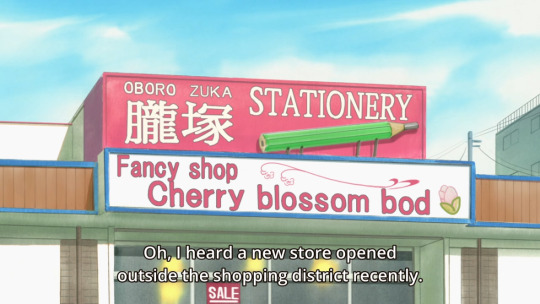
I think this is supposed to be “bud” not “bod,” but I’m not sure if it’s a mistake on Kyoani’s part or an intentional misspelling for realism, because that sort of mistake is a super common sight around Japan.
“Fancy” as a loan word in Japanese is not really associated with “expensive” the way it is in English, but is instead used to refer to cutesy decorative things. “Fancy Shop” is actually a word you can look up in (some) Japanese dictionaries, defined as “a store that specializes in selling ‘fancy’ ‘goods’.” (“Goods” being another common loan word, basically “merch” in English.) You can google image search “ファンシーショップ” (fanshii shoppu) and get a good feel for what it’s like.
Hello Kitty and that whole aesthetic is a decent example as well.
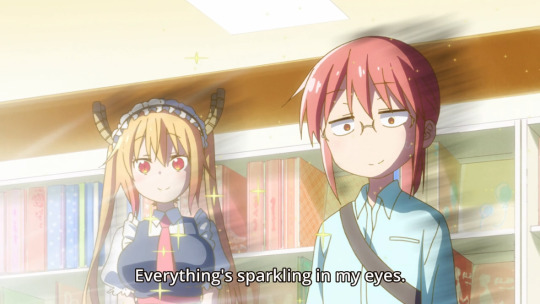
She uses another of those sound effect words here: chikachika. Basically the idea is a prickling sort of pain; it’s not just sparkling, it hurts to look at. It’s a relatively common gag line for an older person to say when looking at “sparklingly” youthful stuff, in that “I’m so old” sort of way.
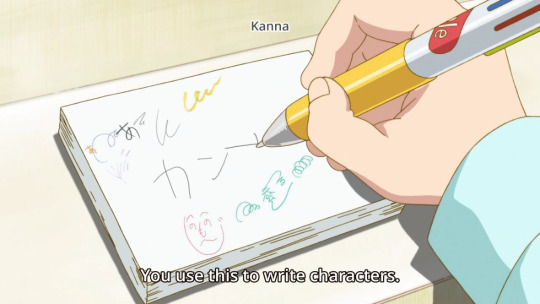
That little face there is the henohenomoheji face—so named because it’s made out of the hiragana he (へ) for the eyebrows/mouth, no (の) for the eyes, mo (も) for the nose, and ji (じ) for the face’s outline and one ear. It’s a popular little doodle and you’ll see it on stuff like scarecrows or background characters in manga (when the author wants to lampshade the fact that they’re meaningless background characters).
|へへ
|のの "
| も /
| へ /
カンナ is Kanna in katakana, the set of kana used primarily for foreign words/names; all of the dragons’ names are written using it. It’s another way “foreigners”* are different from Japanese in Japan, whose names are written in kanji. Well, generally, anyway; some people give their kids (mostly girls) hiragana or, even more rarely, katakana first names, and often very young kids will write their names in kana anyway due to not having learned kanji yet.
*Mostly excluding people from countries that also use Chinese characters to write names, like say China—though even then you can usually tell "oh this is a Chinese name" from the choice of characters.
It’s actually a pain sometimes, as some forms and computer systems are designed with Japanese names in mind, which basically means you’ll never need more than like 4 characters each for first and last name. If you've got a longer name, it often won’t fit in those cases.

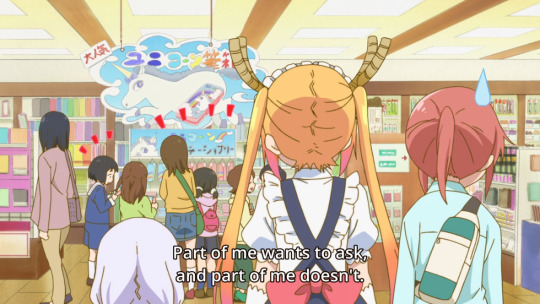
Did anybody miss this joke?

The sign, as you might expect, basically says “Sweets Erasers” and “Warning: Do Not Eat”.

The sign here is pointing out that these are those “safety buzzers” mentioned earlier...which you probably noticed.
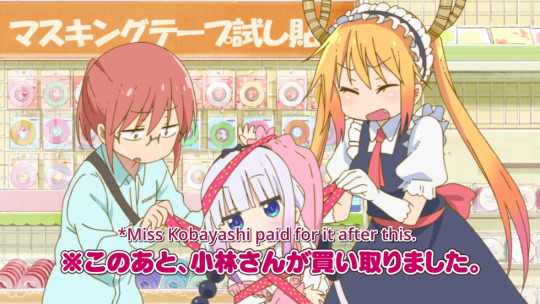
This is a play on a disclaimer(?) message that is/was common on certain Japanese TV shows: “この後スタッフが美味しく頂きました,” basically “the staff enjoyed eating it after this.” Japan suffered some pretty bad food shortages around the end of WW2 and, as cultures tend to do after experiencing that sort of thing, developed a strong norm against wasting food. Due to that, TV shows that wasted food on set felt the need to show that message, “after filming we ate this and were thankful about it; it wasn’t wasted,” to avoid blowback from angry viewers. It sort of occupies a similar spot in the culture that “no animals were harmed in the filming of this movie” does in the US. Both arise from a real effort to hold studios accountable, but are also often used as material for jokes.
The sign in the back specifies that this is masking tape, not ribbon, in case that’s what you thought it was.


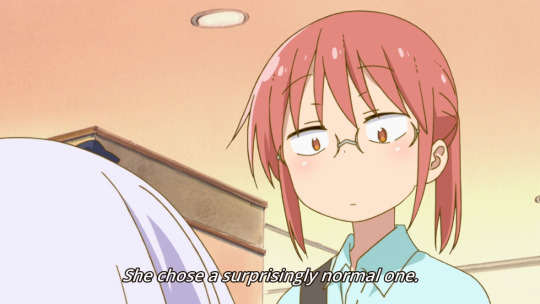

“Backpacks” here is actually a very specific type of backpack, mostly unique to Japan; ランドセル randoseru, originally an old loan word from Dutch: ransel. This type of backpack is exclusively used by elementary school students—and indeed a large majority of elementary school students use them, as has been the tradition for several decades. Like a lot of Japanese school traditions it originally started as a military thing that seeped into the mainstream while Japan was feeling particularly imperialistic.
As you can see, they tend to be stupidly expensive for a backpack. The cost is somewhat deserved at least, as they are mostly handmade from quality materials and will easily endure the whole six years of a child’s elementary schooling. The hard shell that keeps the boxy shape helps keep the kids from breaking or crushing crap they put in it too, so that’s nice I guess.
They tend to have a strong nostalgic value as well, and people will often hold onto them as keepsakes (i.e. stuffed away in an attic or closet to be looked at once every twenty years or so, probably).
In addition to the above (which would not get me to pay that much, personally), many schools have traditionally required, and continue to require, that students use one. Some even mandate the color, though that’s not quite as common as it used to be and nowadays you can get them in a bunch of different colors instead of the traditional black or red*. Even in places where it’s not required, it’s not unheard of for people to use them anyway, again due to tradition and not wanting their kid to be the only one without (which would probably lead to both teasing of the kid by their classmates, and gossip about their parents by other parents).
*Red being a traditional color helps explain why Kobayashi reacted as she did there. In particular, black=boys & red=girls used to be a thing too.
It’s possible to get them for significantly cheaper in places (like online retailers), though those will generally be of lower quality (or at least less fancy materials; you’re probs not gonna find a leather one for 7,000 yen). Fancy designer ones can of course go for absurdly high prices, though that’s true of any product nowadays.
By the way, as you can see here, nigh on everybody carries a bag of some sort in Japan. Since you’re not likely to be using a car, it’s not like you’ve got anywhere else to put stuff you might need to have with you when out and about.

Japan is still largely cash-based when it comes to individual purchases, a fact which provides a little context to this bit. Outside of large chains, many places won’t take cards, and until fairly recently debit cards basically weren’t even a thing—they still haven’t really caught on, but at least you can get one from some of the large banks now.

School uniforms and certain other supplies are largely purchased through small local stores like this; if you’ve lived near a school you’re likely to have seen one. As Kobayashi’s line implied, they often have deals with a school so that you have to buy through them. It reminds me of how you have to buy gowns/hats/etc. for US school graduation ceremonies through a certain vendor the school (district?) has a deal with.

As you’re probably aware, this is a common and powerful sentiment in Japan, especially the more traditional areas. There have been cases of schools forcing children to dye their hair black even if it was naturally another color, which is clearly an example of taking it too far. On the other hand, there is an argument to made for fostering a sense of equality with your peers by having the whole class in the same uniform, with the same shoes, carrying the same bag, etc., so it’s not like it’s purely hard-headed attachment to tradition and conformity. I guess.
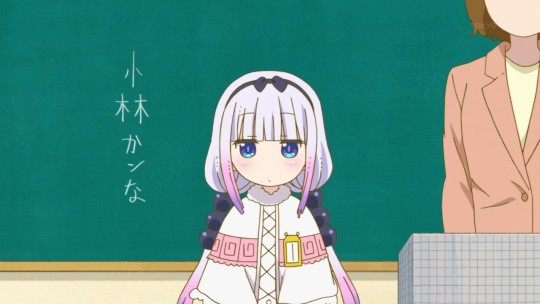
Kanna writes the na in her name with hiragana by mistake (な instead of ナ). ...Or so you’d think, but she was doing a good job writing kanji earlier, so I’m not sure if it’s an honest mistake or a calculated one to appear less infallible. Especially considering the fake tears we see later.
Edit: As has been pointed out, the Ka is also wrong in the same way: か instead of カ. Not gonna lie, I sometimes make that mistake myself when writing them out by hand, since the primary difference is just whether there’s that corner dash and it’s easy to add it out of muscle memory—hiragana is a lot more common to write than katakana.

As mentioned before, handwriting is seen as very important in Japan—in particular, the specific method of how you’re supposed to write any one character (including letters/numbers). I bring this up again here because Kanna totally writes the 9 the “wrong” way.

Cram schools (塾 juku) are private “after-school-schools” that parents put their kids into to improve their chances of doing well on the all-important school entrance exams. They’re often seen as a pretty shitty experience for the kid (who wants to go to school twice in one day? or on days off?), but a necessary evil in order to make sure they can get into a good middle school, to get into a good high school, to get into a good college, to get a good job, to have a good life.

These rags, blue/pink clips, and rack are a common sight in many places in Japan; typically schools and offices where the students/employees do a basic cleaning of the classroom/office.
As you may have noticed in other anime set in schools, students tend to do a lot of the work of keeping the school clean. Part of that is (probably) to save on cleaning costs, but it’s also intended to foster a sense of community among the students and get them feeling invested in the school, as well as teach responsibility.
In many workplaces this tradition continues, to a greater or lesser extent. A white-collar worker might not be cleaning the office bathroom, but they will likely have a weekly (or biweekly, whatever) cleaning event where everybody gets a rag and cleans up any dust, coffee/tea rings, etc. around their desk for a few minutes, maybe do a little vacuuming. It’s as much a team-building exercise as it is a cost-saving technique (in theory).
Of course, it also helps establish that it’s now at the end of the school day.

This is that phrase the dude in episode two was repeating: maji yabakune マジやばくね. The maji is just an emphasis thing, very similar to “really” in English (both like “that’s really weird” or “wow, really?”). “Seriously” works too, especially considering that maji is short for majime 真面目, which is a less slangy word that basically means serious (it’s more than just that but whatever). Depending on use, it may be closer to “rly” or “srsly” instead (interneeeet).
The second word is yabai (or more specifically the negated version of it*, yabakunai, or even more specifically the slangy/slurred way of saying that, yabakune). Yabai is a slang word that’s exploded in popularity over the last several years (though it’s roots are much older). It used to mostly describe a situation that is/had gone bad, similar to something like “oh shit.” Much like “shit” though, it’s become almost a catch-all word you can use to refer to basically anything. “This is shit.” “This is the shit.” “This is my shit.” Another example you’ll hear is using it to refer to people, like “that guy’s yabai,” which can mean anything from “don’t fall in with that dude he dangerous” to “that guy’s nuts” to “damn look at that dude go, fuckin beast mode.”
It’s not quite as vulgar though, so it’s not necessarily a bad word for kids to say.
*An extremely common grammar construction in Japanese is negating something and sticking a question mark after it to make a phrase similar to “Is that not ___?” in English. That’s what’s going on with “yabakune.”
So here, it’s Kanna processing the conflicting statements Saikawa made and being like a combination of “she nuts” and “danger Kanna Kamui, danger” (in a silly sort of way).

The line here technically isn’t want to be friends (友達になりたい tomodachi ni naritai or similar), but want to get along well (仲良くしたい nakayokushitai). It’s a pretty insignificant difference, but it makes slightly more sense in context for her to be saying it that way (at least in the Japanese, where both sound natural).


“Blundering” here is bukiyou 不器用, which is a common adjective for someone who’s clumsy (especially in a “bad with their hands” kind of way) or bad at expressing their emotions. If you’re familiar with the stereotypical gruff Japanese dad who can’t make himself tell his kids he loves them (unless maybe at end of an emotional story arc) archetype, this is the word typically used to describe them.
So basically the nuance here is that they’re all “you should have just said you wanted to be friends with her from the start, why’d you have to be all combative?” Which is probably something they think about her a lot.

For the curious, the words here are kurasu 暮らす and ikiru 生きる. The former is a verb for the act of “living” in a “what you do in your day to day life to get by” type of way; what house you live in, what food you eat, your routine, etc. The latter is “living” in a more philosophical sort of way, like “how you choose to live your life.” Or biologically I guess, like being alive versus being dead.


The way she words this, to me, implies less “for now, I can” and more “now, I can.” Like she couldn’t understand it before, but now she can.
Maybe a better way to put it is that the translation here seems to deal with the “now" and the “future” (she agrees now, but may not in the future) whereas the Japanese phrase used (ima de wa 今では) deals more with the “past” and the “now” (she didn't agree with it, but now she does).
Also for what it’s worth, in the manga there’s one extra line after that: “Kobayashi-san is just that... [trails off]”
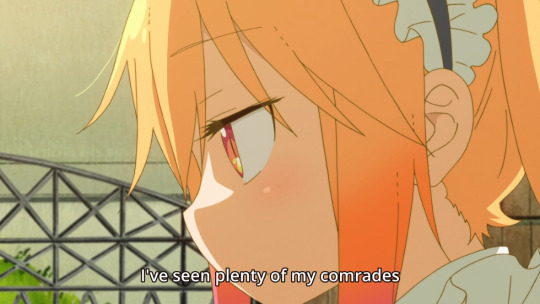

Also going back a bit, this line. The phrase "骨をうずめる hone wo uzumeru" doesn’t really mean to destroy oneself. Literally, it means to bury one’s bones, and idiomatically, it means to “devote yourself wholly to something.” It is (or maybe was, when lifetime employment was still big) commonly used like “I will bury my bones at this company,” meaning you were devoted to your work at that employer (and had no plans to consider leaving for another job in the future).
So the idea here is that she had seen many of her fellow dragons who started with just “I’ll just spend time/get along with this non-dragon” and ended up becoming completely devoted to them instead (romantically or otherwise), but had never been able to accept/understand that feeling/decision—until now.
Also worth noting the "共に tomo ni" (together with) that she used with the bone-burying phrase—the same word she used twice earlier when talking about living with humans (tomo ni kurasu and, tomo ni ikiru).
So depending on how you want to interpret it, idiomatically or literally, the dragons she knew got "too" involved with a non-dragon and then either just became super emotionally attached, or died together with them.

This line is actually "いつの不良だ? itsu no furyou da?". Furyou is one of the words you’ll see as "delinquent" a lot, and itsu is "when." Basically the way they’re acting makes them seem like stereotypical delinquents from year 19XX, and she’s sort of reacting to both how out of date it is, plus the "delinquent" thing itself. If you were writing a similar scene from scratch in English, you might go with a “____ called, it wants its ____ back” style joke.

She’s saying “moe” here, in case you didn’t catch that. That sort of “moeeeee” squeal is pretty stereotypical (if sort of out of date) as a thing Japanese anime otaku would say when looking at something cute. When I say stereotypical, I mean that was kind of the perception even relatively normal people had about what otaku did, “oh those people who go like ‘moeeeee’ at anime, right?”


Get it he’s fat (American) and big (gorilla). Gorilla is a pretty standard jokey way to make fun of someone big and stocky. You’ve probably heard it used in several other anime/manga before (often PE teachers or judo club members, especially with square jaws like that).

The phrase here is kubi wo aratte mattero yo 首を洗ってまってろよ, the ever-popular “wash your neck and wait.” It refers to an old line from back in the samurai days, when it was a thing to wash your neck prior to committing seppuku—after you gut yourself, someone else is supposed to cut your head off, and it would be just dreadful for someone to have to cut a dirty neck, heavens me. Basically the idea is “yer fuckin dead mate.”
This is an example of a sutezerifu 捨て台詞, basically a parting line made by an aggrieved party, like “I’ll get you for this!” or whatever. In fiction it’s heavily associated with the bad guys. If you think of Team Rocket they’re a perfect example.

The phrase for picking a fight in Japanese is “selling a fight” (and “fighting words” can be “selling words (urikotoba 売り言葉)”, as here). Then if someone takes you up on it, they “bought” the fight.

Specifically she has no jinbou 人望, which is basically popularity, but in a “people would go out of their way to help you” sort of way; it’s not the same word you’d use to refer to a popular movie, for instance, or someone who’s “popular” but doesn’t have many friends (that would be ninki 人気).

“Explosive” here is actually the kanji for explode/explosion and heart, so it’s more like “Exploding Heart/Spirit.” It’s actually also the word for ground zero/the center of an explosion, though usually it has another kanji added to the end when used like that (爆心地 bakushinchi).
The ability to just toss whatever kanji together like this to create words that don’t necessarily have an actual meaning, but invoke a sort of emotional response, means you see this thing in titles and taglines and fiction (think attack names) a lot.
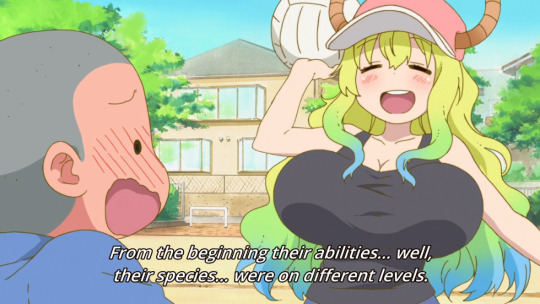
The phrase used to say “on a different level” here is ものが違う mono ga chigau. Chigau is different, and mono can mean many things, including “things,” and also including a euphemism for boobs.

She uses juurin 蹂躙 here, a fancy word for basically trample. It’s not a super common word, but it’s often used when talking about things like “trampled human rights” in news stories.

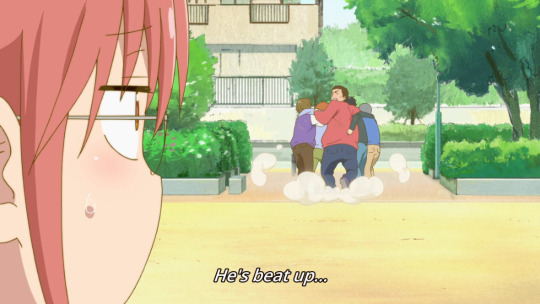
Another sutezerifu, and a particularly stereotypical one. Kobayashi doesn’t say “he’s beat up,” she comments on how absurdly stereotypical he sounds (こってこてだな).

Lucoa uses the first person pronoun “boku,” which is typically used by boys/men. Japanese has a bunch of words for “I/me,” and most of them are gendered to some extent or another; some common ones are ore 俺 and boku 僕 for men, atashi あたし and watashi 私 for women—though watashi (or watakushi) is used by everyone in formal/business environments.
Interestingly, the Japanese language is very gendered based on the speaker, but not so gendered based on the subject. So like in English it can be hard to tell someone’s gender online sometimes, but at the same time it’s useful information to know for pronoun purposes. In Japanese it’s easy to tell someone’s gender online (unless they specifically write to hide it), but at the same time you don’t even really need to know, for pronoun purposes anyway.
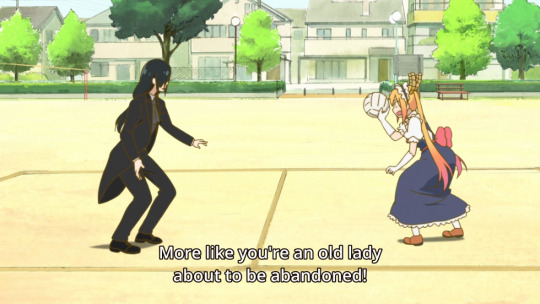
The phrase here is 姥捨て ubasute, an ancient (and possibly mostly mythical?) practice of abandoning elderly people (particularly but not exclusively women) in the mountains or elsewhere in the wilderness to die in times when food was scarce and the extra mouth couldn’t be fed.

You have to remove your normal shoes and change into indoor shoes (like slip-ons), when entering schools in Japan. In middle/high school you’ll typically have a shoe locker to keep those in, but in elementary school you often are required to have a bag to keep them in; hence the “slipper case” here.
Basically the same is true of physical education/gym clothes, hence the “gym clothes case.” The “gym cap” is basically the same deal as the commuting hat, but worn during gym/PE class. They’re often red and white (also reversible), and so sometimes referred to as kouhakubou 紅白帽 (red/white hats; “kouhaku” is a common word, as the red/white color pair has a lot of cultural significance, especially in relation to Shinto).

Bathrooms in Japan don’t have paper towels, so a handkerchief is an important item to carry when leaving the house.

The “pencil board” (下敷き shitajiki) is a thin plastic board placed under paper to provide a better writing surface (such as when writing in a notebook, which would otherwise have more “give” to it). Possibly due to the relatively intricate nature of kanji (look at this shit: 憂鬱), clean handwriting gets a lot of focus in Japanese primary education—calligraphy lessons, with brush and ink and all, are a regular feature of class—which I guess is where the mandatory status of these boards comes from.

The safety buzzer (“crime prevention buzzer”) is a common piece of equipment for kids to carry, so they can ring in case of kidnapping or similar crime; basically the “I need an adult” alarm. Since kids are generally walking to school unattended and there have been a few high profile criminal cases related to that, it makes sense schools would want to make sure these are something students are carrying.
Link to Episode One Notes
Link to Episode Two Notes
Link to Episode Three Notes
Link to Character Intro Pages
134 notes
·
View notes
Text
What Rich Used To Be
From the Slope of Hope: I’ve had a lifelong fascination with wealth and, more recently, wealth disparity (for proof, look no further than the SocialTrade stack on this very topic). I grew up in Baton Rouge, Louisiana in a happy, financially-secure, but very much middle-class family. We lived in this house:
Everyone I knew had the same situation. We all had pretty much the same kind of house, the same quantity of toys, the same simple vacations………everything was so equal, you’d think we were living in some kind of socialist paradise.
We weren’t, of course, and there was, naturally, one “rich kid” in the neighborhood. Everything about his life was just a little bit nicer, starting with the house he lived in:
Doesn’t look too much different, does it? Well, that’s kind of the point of this post.
As a youngster, I was acutely aware of many differences between the life I had and the one my friend Steven (AKA the rich kid) had. Although many decades have passed since then, I don’t have to even try hard to remember some of those contrasts:
The White Carpet
One of my most vivid memories was walking into Steven’s house and seeing stark-white wall-to-wall carpeting. In my house, we had four kids, and white carpet would have been just nuts to have. But in Steven’s, there it was, white and looking good as new. It helped, I suppose, that there was plastic runners, so you had to walk on them, as if it was a plastic sidewalk in the middle of the house. Even as a child, I thought it was kind of silly to carpet a house and then lay down a strip of plastic to protect it, but who was I to say?
The Treehouse
In Steven’s back yard, there was the most gorgeous treehouse. His dad ran a Ford dealership, so I guess he could pretty easily afford a carpenter to come out and construct it for him. Now, when I say “gorgeous”, all I mean was that it looked good to my ten-year-old eyes. It was just a simple cube – – but it was made of high-quality wood, was obviously professionally-constructed, and conjured up much envy within me. I asked my dad every summer if I could have a treehouse, and the response was always the same: “I’ll think about it.” It never came.
The Thunderbird
As I mentioned, Steven’s dad had a dealership (well, at least he was the general manager there), and their family had a nice, new “luxury” car. It was certainly fancier than our station wagon, and I was amazed that it had this thing called “Cruise Control”, which to my young mind meant the car would actually drive itself. Steven and I were in the back seat, and he told me that the little windows were called “opera windows”, which likewise sounded like something far more elegant and expensive than I’d ever own personally.
Dad Salaries
I distinctly remember one conversation my friend and I had in which our father’s salaries came up. Now, I actually had no earthly clue what my father made, but for some reason I was feeling competitive and insecure that day, so I told Steven my father made $ 35,000 a year, which sounded tremendous to me. He countered that if MY dad made $ 35,000 a year, then HIS dad must make $ 50,000 a year. I shut up at that point, because I figured it must be true, given their apparently luxurious lifestyle.
The Boom Boom Cannon
This one seemed to sting the most of all: one Christmas, my “big gift” was a plastic UFO that could fly by way of a motorized propeller. Unfortunately, we couldn’t get the damn thing to fly, in spite of my father’s best efforts. So it was pretty disappointing. I visited Steven to see what he got for Christmas, and he was the proud owner of a tiny working cannon called the Boom Boom (yeah, safety concerns weren’t as prevalent those days……….this was actually a working cannon, with gunpowder, albeit very small). It was made of nice, heavy metal, and I’d never seen one before. It seemed like just about the best toy imaginable.
Looking back, it was as if my dad was 6 feet tall, just like everyone’s else’s dad, and here was my friend who had a dad that was 6 feet and 1 inch tall. Steven’s toys were just a LITTLE bit nicer. His house was a LITTLE bit cleaner. His vacations were a LITTLE bit fancier. But, in truth, the difference between his life and everyone else’s was really, really small. Back then, though, I always felt poor when I was with Steven.
These days, the difference isn’t between a 6 foot guy and someone 6’1″. It’s more like suddenly there are some people who are 900 feet tall – – 1500 feet tall – – 5000 feet tall. Their wealth is just as absurdly large as such heights would be, while at the same time the mass of humanity seems to be getting shorter by the week.
For decades – – mainly the 40s, 50s, and 60s – – wealth distribution in America was incredibly even. Someone very middle-of-the-road could still aspire to be “the rich guy” in town. If my father, for instance, got it in his head that he wanted to win the rat race in our neighborhood, it wouldn’t have been that difficult. It was totally feasible. That extra inch wasn’t unattainable.
Starting in the 70s, thought, and picking up speed in the 1980s, things started to change. Over the past third of a century, policy has clearly handed the wealth of the country over to the rich kids.
Notice the change that took place in 1982. Interestingly, that was exactly the same year that the original Forbes 400 list came out. Their timing couldn’t have been better, because the very existence of such a “rich list” was the equivalent of ringing in an era of plutocracy. But read what the list was like in the inaugural issue………
In the first Forbes 400 list, there were only 13 billionaires, and a net worth of 75 Million USD secured a spot on the list. The 1982 list represented 2.8% of the Gross Domestic Product of the United States. The 1982 Forbes 400 had 22.8% of the list composed of oil fortunes, with 15.3% from manufacturing, 9% from finance and only 3% from technology driven fortunes.
Being a billionaire was a big, big deal. Only 13 entries! These days, just to on the list at ALL, you need a net worth of at least $ 1.7 billion, 23 times higher than the original list. Amazingly, there are nearly 200 people who are billionaires that don’t even make it on the list at all, because they don’t have enough! So the 1982 list seems absolutely quaint in the modern era.
Life tends to move in cycles, and I doubt the scenario in which this massive disparity exists is a permanent feature of life. However, it will take many decades – – and probably more than a little social pain – – to share the wealth again.
All I can say to my younger self regarding my rich friend……….it really wasn’t so bad, and Boom Boom Cannon notwithstanding, financial life was a lot more evenly-balanced back then than it is now. And I still don’t have a treehouse.
source http://capitalisthq.com/what-rich-used-to-be/
from CapitalistHQ http://capitalisthq.blogspot.com/2017/06/what-rich-used-to-be.html
0 notes
Text
What Rich Used To Be
From the Slope of Hope: I’ve had a lifelong fascination with wealth and, more recently, wealth disparity (for proof, look no further than the SocialTrade stack on this very topic). I grew up in Baton Rouge, Louisiana in a happy, financially-secure, but very much middle-class family. We lived in this house:
Everyone I knew had the same situation. We all had pretty much the same kind of house, the same quantity of toys, the same simple vacations………everything was so equal, you’d think we were living in some kind of socialist paradise.
We weren’t, of course, and there was, naturally, one “rich kid” in the neighborhood. Everything about his life was just a little bit nicer, starting with the house he lived in:
Doesn’t look too much different, does it? Well, that’s kind of the point of this post.
As a youngster, I was acutely aware of many differences between the life I had and the one my friend Steven (AKA the rich kid) had. Although many decades have passed since then, I don’t have to even try hard to remember some of those contrasts:
The White Carpet
One of my most vivid memories was walking into Steven’s house and seeing stark-white wall-to-wall carpeting. In my house, we had four kids, and white carpet would have been just nuts to have. But in Steven’s, there it was, white and looking good as new. It helped, I suppose, that there was plastic runners, so you had to walk on them, as if it was a plastic sidewalk in the middle of the house. Even as a child, I thought it was kind of silly to carpet a house and then lay down a strip of plastic to protect it, but who was I to say?
The Treehouse
In Steven’s back yard, there was the most gorgeous treehouse. His dad ran a Ford dealership, so I guess he could pretty easily afford a carpenter to come out and construct it for him. Now, when I say “gorgeous”, all I mean was that it looked good to my ten-year-old eyes. It was just a simple cube – – but it was made of high-quality wood, was obviously professionally-constructed, and conjured up much envy within me. I asked my dad every summer if I could have a treehouse, and the response was always the same: “I’ll think about it.” It never came.
The Thunderbird
As I mentioned, Steven’s dad had a dealership (well, at least he was the general manager there), and their family had a nice, new “luxury” car. It was certainly fancier than our station wagon, and I was amazed that it had this thing called “Cruise Control”, which to my young mind meant the car would actually drive itself. Steven and I were in the back seat, and he told me that the little windows were called “opera windows”, which likewise sounded like something far more elegant and expensive than I’d ever own personally.
Dad Salaries
I distinctly remember one conversation my friend and I had in which our father’s salaries came up. Now, I actually had no earthly clue what my father made, but for some reason I was feeling competitive and insecure that day, so I told Steven my father made $ 35,000 a year, which sounded tremendous to me. He countered that if MY dad made $ 35,000 a year, then HIS dad must make $ 50,000 a year. I shut up at that point, because I figured it must be true, given their apparently luxurious lifestyle.
The Boom Boom Cannon
This one seemed to sting the most of all: one Christmas, my “big gift” was a plastic UFO that could fly by way of a motorized propeller. Unfortunately, we couldn’t get the damn thing to fly, in spite of my father’s best efforts. So it was pretty disappointing. I visited Steven to see what he got for Christmas, and he was the proud owner of a tiny working cannon called the Boom Boom (yeah, safety concerns weren’t as prevalent those days……….this was actually a working cannon, with gunpowder, albeit very small). It was made of nice, heavy metal, and I’d never seen one before. It seemed like just about the best toy imaginable.
Looking back, it was as if my dad was 6 feet tall, just like everyone’s else’s dad, and here was my friend who had a dad that was 6 feet and 1 inch tall. Steven’s toys were just a LITTLE bit nicer. His house was a LITTLE bit cleaner. His vacations were a LITTLE bit fancier. But, in truth, the difference between his life and everyone else’s was really, really small. Back then, though, I always felt poor when I was with Steven.
These days, the difference isn’t between a 6 foot guy and someone 6’1″. It’s more like suddenly there are some people who are 900 feet tall – – 1500 feet tall – – 5000 feet tall. Their wealth is just as absurdly large as such heights would be, while at the same time the mass of humanity seems to be getting shorter by the week.
For decades – – mainly the 40s, 50s, and 60s – – wealth distribution in America was incredibly even. Someone very middle-of-the-road could still aspire to be “the rich guy” in town. If my father, for instance, got it in his head that he wanted to win the rat race in our neighborhood, it wouldn’t have been that difficult. It was totally feasible. That extra inch wasn’t unattainable.
Starting in the 70s, thought, and picking up speed in the 1980s, things started to change. Over the past third of a century, policy has clearly handed the wealth of the country over to the rich kids.
Notice the change that took place in 1982. Interestingly, that was exactly the same year that the original Forbes 400 list came out. Their timing couldn’t have been better, because the very existence of such a “rich list” was the equivalent of ringing in an era of plutocracy. But read what the list was like in the inaugural issue………
In the first Forbes 400 list, there were only 13 billionaires, and a net worth of 75 Million USD secured a spot on the list. The 1982 list represented 2.8% of the Gross Domestic Product of the United States. The 1982 Forbes 400 had 22.8% of the list composed of oil fortunes, with 15.3% from manufacturing, 9% from finance and only 3% from technology driven fortunes.
Being a billionaire was a big, big deal. Only 13 entries! These days, just to on the list at ALL, you need a net worth of at least $ 1.7 billion, 23 times higher than the original list. Amazingly, there are nearly 200 people who are billionaires that don’t even make it on the list at all, because they don’t have enough! So the 1982 list seems absolutely quaint in the modern era.
Life tends to move in cycles, and I doubt the scenario in which this massive disparity exists is a permanent feature of life. However, it will take many decades – – and probably more than a little social pain – – to share the wealth again.
All I can say to my younger self regarding my rich friend……….it really wasn’t so bad, and Boom Boom Cannon notwithstanding, financial life was a lot more evenly-balanced back then than it is now. And I still don’t have a treehouse.
from CapitalistHQ.com http://capitalisthq.com/what-rich-used-to-be/
0 notes